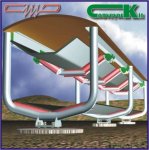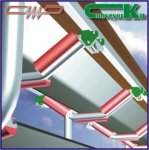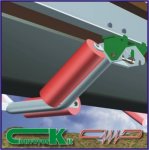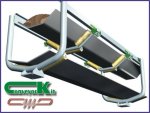
With the extensive development of belt conveyors over the last decade or so, where increasingly larger capacities of bulk materials are being transported over greater distances, many attempts are being made to make the overall conveying system more cost effective.
These attempts are primarily focused on initial capital cost with little or no attention being given to the operating and maintenance cost of the total system. All too often projects are awarded, where the life-cycle or ongoing operating cost dose not play a part in the adjudication of the selected system.
Today there have been some significant developments in the conveyor industry, aimed primarily at cost reductions but also focusing on the future operating costs of the conveyor.

Three major developments have been see in the South African materials handling industry in the past few years these being the belt friendly structure, the triangular gantry and traveling maintenance trolley and the development of the power strip conveyor.
This article will address only the first item (belt friendly structure) however, by clicking on the links the reader can review the other developments as well.
With a view to making the belt conveyor more competitive both in capital and operating costs a team from ConveyorKit SA and Conveyor Dynamics Inc., (CDI), embarked on an exercise to re-engineer the conveyor structure making it more friendly to the conveyor belt and more cost effective to install and maintain.
CDI had recently been involved in a number of conveyors which had been designed with minimal structure (<25 kg/m), however these structures could not be considered belt friendly or flexible enough to be considered for all applications.
The basic principle of these structured revolved around using the line stands (legs) as the carrying structure for the idlers and using a very light section to support the wind sheeting.
This concept is totally acceptable for long straight runs of overland conveyor where idler spacing can exceed 4m on the carry strand and 8m on the return strand. However when one considers both vertical and horizontal curves, (as is often the case with longer conveyors), which invariably requires closer spacing for both load support and stability, the use of such structures is not always practical.
To this end the search for a more practical structure was undertaken. The aim was to develop a structure that was both belt and maintenance friendly, using the minimum amount of line stands thereby reducing civil costs and being practical for both overland and plant conveying systems.
An underground decline conveying system was to be developed which lent itself perfectly to this development. The conveyor was required to operate in a confined space (tunnel), it was necessary to minimize the civil scope because of the difficulties in accurately constructing foundations and the belt had to be protected from operational damage at all costs.
The designers opted for a pipe construction for the line stands and the “wine glass” format was born. Being mounted on a single central support the frame was easy to build and required half the foundations of conventional systems.
Alignment was also simplified by allowing the frame to be leveled in a three dimensional plain using the 4 centrally positioned holding down bolts.
In the event of damaged or lost idlers belt simply runs on the tubular frame, thus unaffected by sharp steel edges.
To overcome the problem of line stand spacing in curves the carry idlers were moved off the line stand and placed on a support stringer spanning between the line stands.
The return idlers remained on the line stands thus the distance between the line stands became a function of return idler spacing only, which in most instances can be 10m or more.
The design of the support stringer now becomes the area of structural optimisation with numerous sizes and shapes of stringer and stringer connection being considered.
The optimum shape was shown to be the cold rolled “Z” section which has the advantage of being made to any basic dimensional requirement and thus could be dynamically tuned to suit the structural loads and conveyor dynamics.
Allowing the carry idlers to be placed on the stringer has two distinct advantages firstly, the idler support frame could also be tubular (again belt friendly), and the recently developed quick release idler frame could also be used in the required areas, (more of this later).
As can be seen in the above sketch the structure is very basic and can be considered as simple to construct however, when one tries to manufacture the structure to compete commercially with the more conventional structures, there are areas of concern.
We have been able to overcome these problems by carefully analysing each component in the construction and selecting the correct detailing, fabrication, and jigging to arrive at a cost effective solution.
Initially we used jobbing shops to undertake the fabrication, however these facilities could not produce the repeatability, accuracy and speed necessary to make the structures competitively.
By turning our attention to mass production facilities we were able to produce the required results at a cost effective price. To-day we consider that we are able to compete favourably with any conventional stringer structure.
One area where we still have some concerns is the corrosion protection of the wine glass frame notably where hot dip galvanising is used, which tend to distort the frame.
This is under review at the moment and will be minimised because we are not relying on the upper part of the frame to carry the idler brackets therefore not requiring close tolerances.
When undertaking the cost analysis of this system in comparison with the conventional structures then on a cost per ton basis there is a premium of 13% to pay for the belt friendly “wine glass” structure. This premium is reduced if the conveyor route incorporates a number of vertical or horizontal curves. However the civil and erection costs are substantially reduced compared with any other system, making the overall installed cost comparable with conventional structures.
When one considers the benefits of the structures to the operating and maintenance costs of the overall system, be it used in plant or on overland conveyor applications, then the “wine glass” structure is set to become the norm for the future.
The quick release idler has been developed to compliment the “wine glass” structure, incorporating a conventional tubular idler frame as seen in the sketch below, mounted on a special bracket that can easily lower the idler away from the belt for maintenance.

This feature i.e. the ability to lower the idlers away from the operating belt, lends itself primarily to use in haulage shafts and other conveyor applications where the belt tensions are so high that idler change outs are very difficult without special rigging equipment.
It is also convenient to the Beltsman who is able to travel the conveyor release damaged idlers, which otherwise would in turn damage the belt, enabling there idlers to be replaced and re-engaged during the convenience of a shut down.
The sketch following give a clearer indication of the quick release mechanism.

One can see the conventional tubular idler support frame, however the end connection to the frame has been changed to incorporate a sliding bracket, which can be lowered by the Beltsman to remove the idler and frame away from the belt.
The idler is lowered far enough away from the belt to allow it to be lifted out of its cradle are replaced without having to lift the belt
